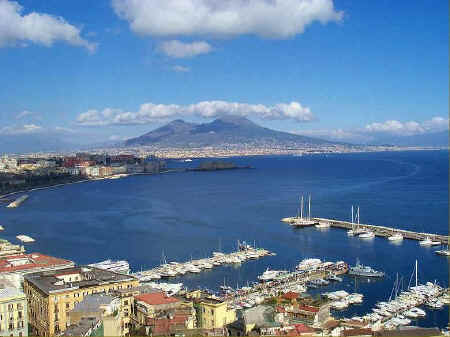
|
Naples main sights |
|
Naples excites strong reactions among those who live here and those who visit us. Some see Naples as a dirty and dangerous city while others find it a place of inexhaustible interest. It is, in fact, both of these things. There's no doubt that Naples crawls with pickpockets, bag snatchers and sneak thieves, both native and, increasingly, foreign (Kosova and Romania spring to mind), who prey on tourists as well as Neapolitans. Naples is also home to excellent museums, a fine national library, a wealth of baroque churches, great food and one of the most beautiful seafronts in the world. Nearby are Vesuvius and Pompeii, as well as the islands of Capri and Ischia, and the Sorrento peninsula. In the final analysis, it would be a major error to miss any opportunity you might have to spend some days or weeks here in Naples. |
The Bay of Naples in Italy, with Vesuvius in the background
Naples, Italy - the main piazzas, palaces and castlesPiazza del PlebiscitoThe central and main piazza of
Naples is the Piazza del Plebiscito. It was initiated by the Bonapartist King Joachim Murat and finished by
the Bourbon King Ferdinand IV. It is bounded on the east by the Royal Palace and on the west by the
Church of San Francesco di Paola, with the colonnades extending to both sides. Aside from the main piazza there are the Piazza Dante and the Piazza dei Martiri. The latter is somewhat controversial: it originally just had a memorial to martyrs but in 1866, after the Italian unification, four lions were added, representing the four rebellions against the Bourbons. Castel Nuovo
Naples is well-known for its historic castles: the ancient Castel Nuovo
(Maschio Angioino) is one of the most notable structures of Naples.
It was built during the time of Charles I, the first king of Naples. Pope Celestine V resigned as pope in a hall of the castle, and following this Pope Boniface VIII was elected pope here by the cardinal collegium, and immediately moved to Rome.
Castel dell'Ovo The third castle of note is Sant'Elmo which was completed in 1329 and is built in the shape of a star. During the uprising of Masaniello, the Spanish took refuge in Sant'Elmo to escape the revolutionaries.
Palazzo CapodimonteNaples hosts a wealth of historical museums and some of the most important in the country. The Naples National Archaeological Museum is one of the main museums, considered one of the most important for artifacts of the Roman Empire in the
world. It also hosts many of the antiques unearthed at Pompeii and Herculaneum, as well as some artifacts from the Greek and Renaissance
periods. Certosa di San MartinoThe Certosa di San Martino was formerly a monastery complex but is now a museum and remains one of the most visible landmarks of Naples. Displayed within the museum are Spanish and Bourbon-era artifacts, as well as displays of the nativity scene, considered to be among the finest in the world. Pietrarsa railway museum is located in the city: Naples has a proud railway history and the museum features, amongst many other things, the Bayard, the first locomotive in the Italian peninsula. Other museums include the Villa Pignatelli and Palazzo Como, and one of Italy's national libraries (the Biblioteca Nazionale Vittorio Emanuele III) is also located in the city.
Churches, religious buildings and other structuresMiracle of Saint JanuariusThe Catholic faith is highly important to the people of Naples and there are hundreds of churches in the city. The Cathedral of Naples is the most important place of worship in the city and, each year on 19 September, it hosts the Miracle of Saint Januarius, the city's patron saint. In the miracle, which thousands of Neapolitans flock to witness, the dried blood of Januarius is said to turn to liquid when brought close to relics said to be of his body: this is one of the most important traditions for Neapolitans. San Gennaro dei PoveriSan Gennaro dei Poveri was founded in 1667 by the Spanish as a hospital for the poor which is still in existence today. It was a forerunner of a much more ambitious project, the gigantic Bourbon Hospice for the Poor started by Charles III. This was for the destitute and ill of the city. It also provided a self-sufficient community where the poor would live and work. Today it is no longer a hospital. Monastery and Church of Santa ChiaraSanta Chiara includes the Church of Santa Chiara, a monastery, tombs and an
archaeological museum. Cloister of Santa Chiara Public parks in NaplesThe Villa Comunale, previously known as the Royal Garden
because it was founded by the Bourbon King Ferdinand IV in the 1780s, is
the most famous public park in Naples. The second most important park is Parco Virgiliano which is very green and has views towards the tiny volcanic islet of Nisida
and beyond to Procida and Ischia. The park is named after Virgil whose
tomb is thought to be nearby. |
Naples Napoli © ammonet InfoTech 2009 - 2020. All rights reserved.